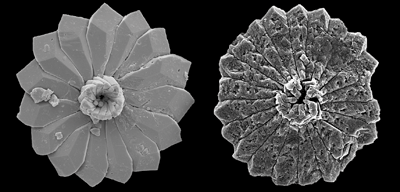Oceans Acidifying Faster Today Than in Past 300 Million Years

02/03/2012
The research was led by scientists of the universities of Columbia, USA, and Bristol, UK, and included the participation of Carles Pelejero, CSIC ICREA researcher.
Marine acidification occurs when CO2 emissions produced by human activities, mainly by the burning of fossil fuels, dissolve into the oceans. Over 30% of anthropogenic CO2 emissions go straight into the oceans, which are becoming progressively more acidic. Acidification harms many marine life forms and interferes with the development of shell-building species and those with calcium-carbonate skeletons such as corals and molluscs. It also can affect phytoplankton species, which are an essential part of the marine trophic network feeding fish, crustaceans and other species.
Large part of the research into this subject is based on experiments carried out in aquariums simulating future acidifications and assessing the response of organisms. This research however has analysed geological records using palaeontological and geochemical analysis and past acidification episodes to detect possible effects on the marine biota.
The research detected specific moments in the history of the Earth associated with profound acidification, such as the Paleocene?Eocene Thermal Maximum occurring some 56 million years ago. ?Due to volcanic emissions and the destabilisation of frozen methane hydrates on the ocean floor, large amounts of carbon were freed into the atmosphere, comparable to levels humans may achieve in emitting in the future. Large extinctions took place during that period, especially of benthic fauna. Nevertheless, CO2 injections were at least ten times slower than occurring now, which augurs more catastrophic consequences caused by current anthropogenic changes?, states Carles Pelejero, researcher at the CSIC Institute of Marine Sciences and ICREA.
Geological records offer details on the biological changes associated with other large-scale global disturbances, such as that occurring after an asteriod hit Earth and marked the end of the Cretaceous Period, 65 million years ago, and which is also thought to be the cause of ocean acidification.
Other extinctions, such as at the end of the Triassic Period 200 million years ago, and the end of the Permian Period, also could have been the cause of important acidification processes. Although all have also been associated with reduced levels of oxygen in oceans and a high rise in temperatures. In fact, these three environmental factors are the ones most globally affecting oceans presently: global warming, acidification and decrease in oxygen.
?Considering the effects we detect through fossil records, there is no doubt that we must attack the problem at the root as soon as possible, adopting measures to immediately reduce our CO2 emissions into the atmosphere? concludes Patrizia Ziveri, researcher at ICTA.
Reference article: B. Hönisch, A. Ridgwell, D.N. Schmidt, E. Thomas, S.J. Gibbs, A. Sluijs, R. Zeebe, L. Kump, R.C, Martindale, S.E. Greene, W. Kiessling, J. Ries, J.C. Zachos, D.L. Royer, S. Barker, T.M. Marchitto Jr., R. Moyer, C. Pelejero, P. Ziveri, G.L. Foster, B. Williams. "The geological record of ocean acidification". Science. DOI: 10.1126/science.1208277.
Foto: Images from a scanning electron microscope (SEM) of a very abundant calcareous nannofossil (Discoaster) displaying the effects of a known episode of ocean acidification in these marine planktonic organisms. The change occurred 56 million years ago during the Paleocene?Eocene Thermal Maximum (PETM) and is discussed in the article published in Science. To the left there is a relatively well preserved specimen from before the disturbance. To the right is a specimen corroded by the acidification process. These organisms are about 10 µm (micrometres) large.